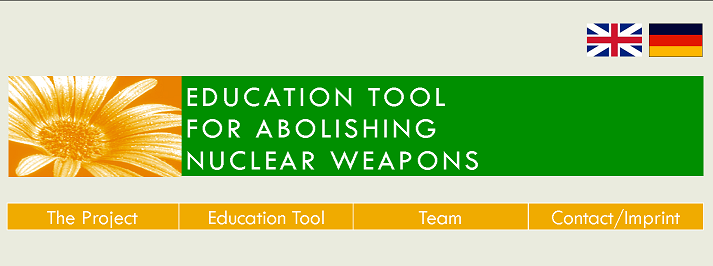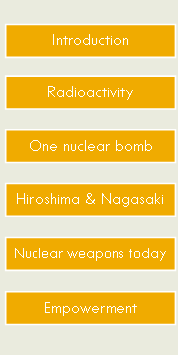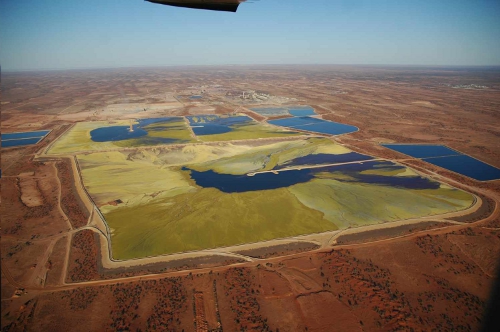

|
One nuclear bomb
Effects of a nuclear bombA nuclear bomb has impacts even if it is not used:Uranium Mining and production of fissile material The suffering caused through Uranium mining is mostly ignored by media and civil society. Of course most of the Uranium is mined for nuclear power and not for nuclear bombs but it feeds the same nuclear fuel cycle and the fuel used for power can also be used for bombs after reprocessing. Uranium mining not only destroys the environment and is dangerous for the workers working in the mines - mostly indigenous people. It also causes conflicts in the regions about mining rights and working places as well as about the more limited resources of land and water needed for mining. In the fuel cycle also a lot of radioactive waste is produced. The radioactive tailings, produced through the extraction while the Uranium milling, are a crucial pollution of the environment in the mining areas which nobody is able to control. Learn more about it in the chapter of nuclear fuel cycle.  Money spend for bombs not for food Every 3.6 seconds a children dies of hunger. The industrial countries cutting their budgets on development aid but also on their own social systems while military spending is increasing - you get what you pay for. 40 Billion US-Dollar does the US spend every year on weapons - the same amount of money the United Nations would need to reach the UN Millennium Development Goals by 2020. The effects of a detonation of a nuclear bomb are:
Method: Target "X"MATERIAL: permission for event, map of your city, red markers, calculator, big red cross out of fabricTIME AND LOCATION: School compound or city center, preparation time and 2-4 hours for event With this method you can raise public awareness and educate about the effects of a nuclear bomb. You put up a big red cross on the ground to mark a hypothetical "ground zero" of an explosion of a nuclear bomb. You can put up pictures from Hiroshima and Nagasaki as well as spread flyers with information explaining the action. You need to hang up a map of the city you are located the action and mark the place you are standing as ground zero. Than you can draw the circles, as you see them in the pdf-file, to mark the range of effects and hang up a sign with the filled in table from below. Here a 12kt bomb is used - similar to the Hiroshima bomb. Fill in the number of the population of the target city. To calculate the total deaths, multiply the approximate population by the fatality rate and then divide it by 100.
Science and ResponsibilityHow does a nuclear bomb explode? Like it is explained in the chapter "radioactivity" a critical mass of radioactive material is needed for an explosion. It can't be one part because than the chain reaction would get started from a natural decay. The material must be cut into two more pieces who do not react but can put together to a sphere which is the ideal form for a reaction and reaches the critical mass or more.The first three bombs were constructed in the so called Manhattan project: the first was a plutonium bomb "Gadget", tested on 16 June, 1945, the uranium bomb "Little Boy" was dropped on Hiroshima and the plutonium bomb "Fat man" destroyed Nagasaki. The construction of all three bombs was very simple compared to nuclear weapons existing nowadays. Today the ignition is very complex and also flexible choice of the explosion power is possible. Also the delivery systems are very advanced of course. Little Boy The radioactive material for the Hiroshima bomb was a sphere of Uranium-235 from which a cone was cut out. For the ignition the Uranium cone is shot into the sphere by conventional explosive material. A critical mass is created. For Uranium-235 It is 50kg which is a sphere of 17cm diameter. But there was no mere Uranium so that 100kg of polluted Uranium was used. Because of this extraordinary mass it was impossible to built a test bomb for "Little Boy". The freed energy of the Hiroshima bomb is equal to 13000 tons (13kt) TNT, a conventional explosion material. The temperatures at the explosion were up to 10 million degrees Celsius. Technical data: 
Fat Man The radioactive material of this bomb was Plutonium 239, surrounded by Uranium-238 for reducing the critical mass to 10kg. This is because U-238 isn't that more likely to react as U-235 and therefore does not splitting when shot with neutrons but reflects them. So some of the neutrons trying to leave the nuclear fission are shot back and the Plutonium is used more efficient. Because Plutonium is more likely to react than Uranium the mass need to be split into several parts of the same size formed like pyramids. With a special technology for ignition called implosion the material gets compressed 2.5 times and is even more likely to react so you need even less material and have a higher explosion power. The parts of Plutonium are fired on one point at the same time to form a ball. Technical data:
MATERIAL: printed quote-cards, if possible on stabile paper TIME AND LOCATION: 10-20 minutes, informal round Hand the cards to the participants. Make sure there are enough for everybody or form small groups before. Give them some time to think about their quotes and then ask them to read them out and give their thoughts on those. Then leave their floor open for a discussion. If a discussion is not developing you can ask them to find relations between the quotes or ask them what they know about the person who the quote is from. "Science does not need humans who missed to advocate for sanity. They should be chased out in shame." - from "Life of Galilei" by Bertold Brecht "At the time of being admitted as a Member of the medical profession I solemnly pledge to consecrate my life to the service of humanity" - from the Declaration of Geneva for physicians "There are risks you should never take: The doom of humanity is one of those." - from "The Physicist" by Friedrich Dürrematt "We reached the end of our way. But Humanity isn't that far. We struggled to the front but nobody is following us now and we reached the emptiness. Our science became horrible, our research dangerous, our knowledge deadly." - from "The Physicist" by Friedrich Dürrematt "I can't anticipate the results and the application possibilities, which are enabled by my discovery" - from "The case of Robert Oppenheimer" by Heinar Kipphardt "I think, that my discovers are neither good nor bad, neither moral nor immoral, but just real. You can use them or misuse them." - from "The case of Robert Oppenheimer" by Heinar Kipphardt "There must be no barriers to freedom of inquiry ... There is no place for dogma in science. The scientist is free, and must be free to ask any question, to doubt any assertion, to seek for any evidence, to correct any errors." - by Robert Oppenheimer "At a time when science plays such a powerful role in the life of society, when the destiny of the whole of mankind may hinge on the results of scientific research, it is incumbent on all scientists to be fully conscious of that role, and conduct themselves accordingly." - von Joseph Rotblat "But scientists on both sides of the iron curtain played a very significant role in maintaining the momentum of the nuclear arms race throughout the four decades of the Cold War." - von Joseph Rotblat "I did not imagine that the second half of my life would be spent on efforts to avert a mortal danger to humanity created by science." - Joseph Rotblat "Technological progress is like an axe in the hands of a pathological criminal." - Albert Einstein "Our scientific power has outrun our spiritual power. We have guided missiles and misguided men." - by Martin Luther King, Jr. |
Supported by:
|
Sponsored by:
|
Further Ressources on Disarmament Education: |

